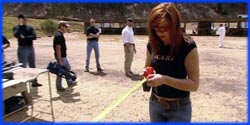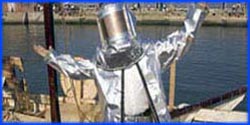


Premier Date: August 14, 2014
confirmed
Adam and Jamie set up a circular course to create experimental traffic at the Alameda runway. With a light traffic situation of ten cars, ripples were observed when Jamie hit his brakes, but these ripples quickly dissipated. A heavier traffic situation of twenty cars (which was very close to the saturation point of the course at the test speed of 20 miles per hour (32 km/h)) resulted in the ripples propagating around the test course multiple times, confirming the myth.plausible
The Build Team had a race of 380 miles (610 km) from San Francisco to Los Angeles, between Tory on a plane, and Kari and Grant driving. The bottlenecks of air travel (arriving early to get through security, waiting for the plane to start boarding, retrieving luggage at the destination, and renting a car) delayed Tory significantly. Kari and Grant had fewer such delays, but did have to stop for gas and food at one point, and traffic in and near the larger cities did slow them down. Kari and Grant arrived at their destination after 5h 33m; Tory was slightly faster, at 5h 25m. Because of the close result and variables that could alter the result either way, this myth was declared plausible.busted
To test this myth, the Build Team had a race on the freeway during morning rush hour, from the workshop in San Francisco to the San Jose Tech Museum. Kari, in the weaving car, managed to open up only a minute and a half lead over Tory in the fixed-lane car before the traffic cleared, resulting in only a 2% difference in travel time. They tried again with more extreme traffic conditions on Interstate 580. This time Grant drove the weaving car and Tory drove the fixed-lane car. Once again, the time difference was small, with a difference of only two minutes over two hours of travel time. One last test along I-580 with four lanes driven by staff members, and Tory in the weaving car, finally showed significant differences between weaving car and the other cars (outlined below), busting the myth. However, the Build Team pointed out that the significant stress on the driver of the weaving car was not worthy of the time gained by weaving.confirmed
At a parking lot in Benicia, CA, Adam and Jamie first marked out a four-way intersection using traffic barriers. Over two tests, fifteen minutes each, the intersection allowed an average of 385 cars to pass through. They then changed the intersection to a roundabout, and after allowing the drivers some practice to get used to navigating the roundabout (as they are not common in the United States), ran the test again. The roundabout allowed multiple cars to be in the intersection at once, resulting in a total of 460 cars passing through in fifteen minutes (a 20% improvement). As a side myth, the test was also run on the four-way intersection with Jamie as a traffic cop, but fewer than 300 cars made it through the intersection in the fifteen-minutes.Previous: Episode 220: Laws of Attraction